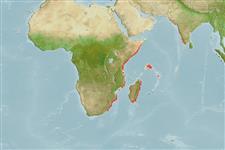>
Kurtiformes (Nurseryfishes, cardinalfishes.) >
Apogonidae (Cardinalfishes) > Apogoninae
Etymology: Taeniamia: Name from feminine Latin noun 'taenia' meaning ribbon or band; and feminine Greek noun 'Amia' meaning a fish, often used with cardinalfishes genera. Here as Taeniamia referring to the vertical wide bars and near vertical to curved narrow bars as lines on most of the species in this genus.; flavofasciata: From the Latin word 'flavus' for yellow and 'fascia' for bar or stripe, referring to the dusky yellow bars on the body..
More on authors: Gon & Randall.
Environment: milieu / climate zone / depth range / distribution range
Sinh thái học
Biển; Mức độ sâu 3 - 13 m (Ref. 54391). Tropical
Sự phân bố
Các nước | Các khu vực của FAO | Các hệ sinh thái | Những lần xuất hiện | Point map | Những chỉ dẫn | Faunafri
Western Indian Ocean: east coast of Africa from Mombasa, Kenya to Durban, South Afrcia, and Madagascar.
Bộ gần gũi / Khối lượng (Trọng lượng) / Age
Maturity: Lm ? range ? - ? cm
Max length : 7.9 cm SL con đực/không giới tính; (Ref. 54391)
Short description
Hình thái học | Sinh trắc học
Các tia vây lưng cứng (tổng cộng): 7; Các vây lưng mềm (tổng cộng): 9; Tia cứng vây hậu môn 2; Tia mềm vây hậu môn: 12 - 14. Diagnosis: Color in life pinkish gray with about 7 dark-edged dusky yellow bars on the side of the body; the dark caudal spot round to slightly oval, about pupil size. Rays: Dorsal VI + 1,9; Anal II,12-14; Pectoral rays 14 (rarely 15). Gill rakers 5-7 + 15-16. Lateral-line scales 25+3-4. Median predorsal scales 6 (one with 7). Body depth 2.3-2.6 in SL; body width 2.3-2.7 in body depth; eye diameter 2.5-3.25 in head length; first dorsal spine 2.6-3.4 in second spine; second dorsal spine 1.9-2.3, and third dorsal spine 1.9-2.4 in head length; spine of second dorsal fin 2.2-2.75, and second anal spine 2.5-3.05 in head length; pelvic-fin length 4.2-4.75 in SL; caudal-peduncle length 4.45-5.2 in SL; distance from insertion of pelvic spine to anal-fin origin 4.4-5.25 in SL. Posterior preopercular edge usually fully serrate. Very small teeth 1-6 , usually present in a middorsal row posteriorly on tongue; extent of scaly sheath along anal-fin base at most moderately developed (Ref. 54391).
Found in seagrass beds in shallow water and was collected by trawl between 3 - 13 meters (Ref. 54391).
Life cycle and mating behavior
Chín muồi sinh dục | Sự tái sinh sản | Đẻ trứng | Các trứng | Sự sinh sản | Ấu trùng
Gon, O. and J.E. Randall, 2003. Revision of the Indo-Pacific cardinalfish genus Archamia (Perciformes: Apogonidae), with description of a new species. Indo-Pac. Fish. (35):49 p. (Ref. 54391)
IUCN Red List Status (Ref. 130435)
Threat to humans
Harmless
Human uses
Thêm thông tin
Các nướcCác khu vực của FAOCác hệ sinh tháiNhững lần xuất hiệnNhững chỉ dẫnStocksSinh thái họcThức ănCác loại thức ănThành phần thức ănKhẩu phần
Tên thường gặpCác synonym ( Các tên trùng)Trao đổi chấtCác động vật ăn mồiĐộc học sinh tháiSự tái sinh sảnChín muồi sinh dụcĐẻ trứngTổng số cá thể đẻ trứngSự sinh sảnCác trứngEgg development
Age/SizeSự sinh trưởngLength-weightLength-lengthLength-frequenciesSinh trắc họcHình thái họcẤu trùngSự biến động ấu trùngBổ xungSự phong phúBRUVS
Các tài liệu tham khảoNuôi trồng thủy sảnTổng quan nuôi trồng thủy sảnCác giốngDi truyềnElectrophoresesDi sảnCác bệnhChế biếnNutrientsMass conversion
Các công cụ
Special reports
Download XML
Các nguồn internet
Estimates based on models
Preferred temperature (Ref.
123201): 24.4 - 27.8, mean 26.9 °C (based on 223 cells).
Phylogenetic diversity index (Ref.
82804): PD
50 = 0.5001 [Uniqueness, from 0.5 = low to 2.0 = high].
Bayesian length-weight: a=0.01479 (0.00690 - 0.03171), b=3.09 (2.91 - 3.27), in cm total length, based on LWR estimates for this (Sub)family-body shape (Ref.
93245).
Mức dinh dưỡng (Ref.
69278): 3.5 ±0.5 se; based on size and trophs of closest relatives
Thích nghi nhanh (Ref.
120179): Chiêù cao, thời gian nhân đôi của chủng quần tối thiểu là dưới 15 tháng (Preliminary K or Fecundity.).
Fishing Vulnerability (Ref.
59153): Low vulnerability (10 of 100).
